The use of nitrogen fertilizers in the garden: what are they, when (in spring) and how to use them correctly, application rates
So, you got to this article, obviously, because you are either worried about the peculiarities of using nitrogen fertilizers (when and how to use them), or you just want to get a list of the most popular ones (list of nitrogen fertilizers). Next, you will learn both.
From this material, it will become clear to you how important nitrogen is for the growth and development of any plant, what happens when there is a shortage and overdose, as well as what organic and mineral nitrogen fertilizers exist (and are available for purchase), how to use them correctly, when and in what form to be applied to the soil, can it be sprayed (do foliar dressing on the leaves).
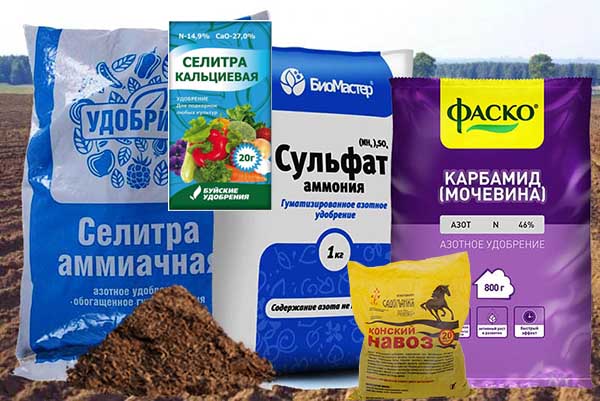
Content
Why are plants so needednitrogen
Nitrogen is the most important and necessary nutrient of any plant (2nd place is taken by phosphorus, 3 - potassium, 4 - sulfur).
So how important is nitrogen to plants?
- Nitrogen is the main building material of the plant, in other words, due to nitrogen, the aerial part of the plant grows, the green mass is set.
That is why the plant needs nitrogen in the first half of the growing season, i.e. in spring and early summer.
Signs of nitrogen starvation of plants
With a lack of nitrogen in plants, the following deviations in development are observed:
Lack of nitrogen leads to a slowdown in biosynthesis processes and a sharp weakening of the intensity of photosynthesis, which is the basis for the development of all plants.
The color of the leaves changes
- with an initial lack of nitrogen, the leaves acquire a pale green color;
- with prolonged nitrogen starvation, the lower leaves turn yellow (depending on the type of plant, they can acquire an orange or even red tint);
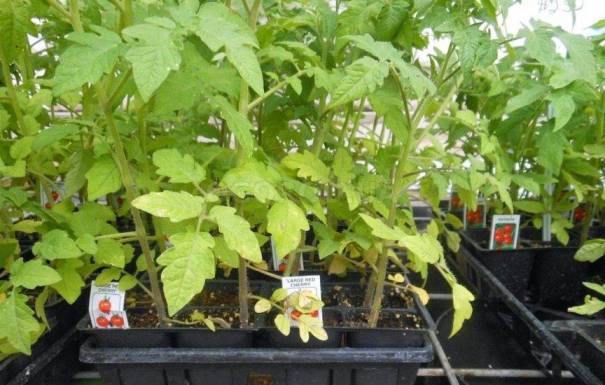
- in the case of strong and prolonged starvation, necrosis on the leaves (necrosis of their tissues) is possible.
General growth retardation and a decrease in the growing season
- the shoots and stems of the plant become thin and soft.
In the case of seedlings, it begins to stretch (as with a lack of light).
As a result, starvation leads to a shorter growing season and earlier ripening of fruits, which negatively affects the final yield.
Consequences of nitrogen oversaturation
An overdose of nitrogen fertilizers can lead to to excessive growth of aboveground (green) mass (shoots, leaves) plants to the detriment of flowering and fruiting (= yield).
For example, if you overfeed your tomatoes with nitrogen fertilizersthen plants will start fatten, they have a powerful and thick stem is formed, and the upper leaves will curl (the top will become curly).
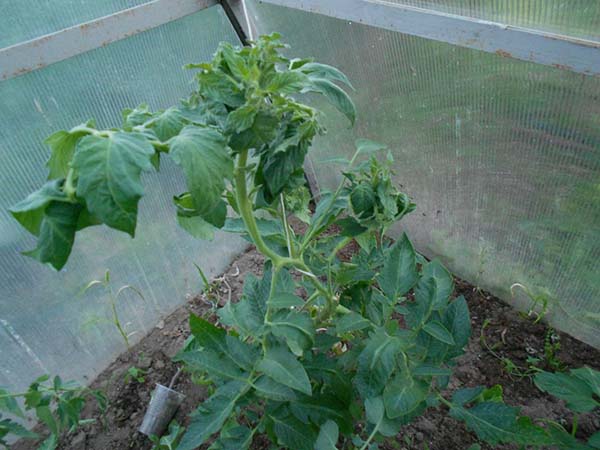
What to do?
You have no choice but to try flush nitrogen from soil, namely spill plenty of water (suitable only for those who have sandy or sandy loam soil). But pouring is also harmful! (especially on heavy soils where moisture stagnates).
Much more effective will be make potassium dressing (potassium will balance nitrogen, stop its excessive consumption by the plant), and even better, carry out foliar dressing (spraying) on the leaves... For example, you can prepare a solution of potassium sulfate or wood ash. Phosphorus will also help balance the nitrogen in the soil, which means you need some phosphorus fertilizer, eg, superphosphate or better yet potassium monophosphate (phosphorus-potassium fertilizer).
Important! Excess nitrogen in the second half of the growing season can also negatively affect on the accumulation of nitrates, especially for root crops (beets, carrots) and cabbage. Which, in turn, will also negatively affect in storage these vegetables.
When to use nitrogen fertilizers: when to apply and how best to feed
As we found out earlier, plants require nitrogen. during the period of active development of vegetative (green) mass, i.e. in spring and first half of summer, usually, before flowering.
The only exception is ammonium sulfate and partly ammonium nitrate (but it's still better in spring!). They can be applied to the garden in the fall (September-October), as well as in the spring.
Thus, most nitrogen fertilizers (except ammonium sulfate) need to be applied for vegetable and fruit culture from April to mid-Julyand under decorative (flowers) until early August.
Note! In the future, the introduction of nitrogen fertilizers will only have a negative effect, since they can decrease winter hardiness and frost resistance of perennial plants.
Groups of nitrogen fertilizers by forms of nitrogen
Plants cannot use free nitrogen, in other words, plants do not have access to atmospheric nitrogen.
Therefore, special forms of nitrogen are used to fertilize plants.
There are 5 groups of nitrogen mineral fertilizers (by forms of nitrogen):
- nitrate (sodium and calcium nitrate);
- ammonium or ammonia (ammonium sulfate, etc., including ammophos);
- ammonium nitrate or ammonium nitrate (ammonium nitrate and calcium ammonium nitrate);
- amide (urea);
- liquid nitrogen or ammonia (ammonia water or aqueous ammonia, anhydrous ammonia, etc.).
The latter include feeding very popular on the Internet. pharmacy ammonia solution (ammonia)... However, this is a very ineffective and rather toxic fertilizer.
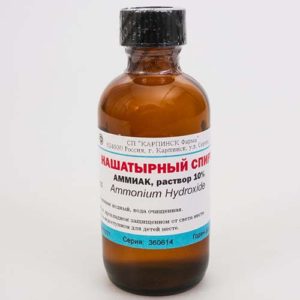
Naturally, there are also organic matter containing nitrogen (see more details in a separate paragraph).
Nitrate form (calcium nitrate)
Nitrate fertilizers are well and quickly absorbed plant roots, therefore, feeding, as a rule, is performed in liquid form, under the root during the growing season, or dry - when preparing the bed before planting (planting) plants in the spring... Also often done foliar top dressing (from top rot of fruit).
When preparing the beds in autumn nitrate fertilizers do not contribute, i.e. they washed out with water.
Fertilizer data especially effective on acidic soils (the same sod-podzolic), because their continued use shifts the soil reaction from acidic to neutral (i.e. they deoxidize the soil, make it more alkaline).
With regard to the scope, then sodium nitrate most effective when making for root crops (beets, carrots), and calcium saltpeter - for feeding bulbous plants, winter crops, grains and most other vegetable crops (especially tilled crops - crops requiring row-spacing, including potatoes).
Ammonium form (ammonium sulfate)
Ammonium fertilizers are quickly absorbed by the roots of plants in the warm season. As a rule, such fertilizers are used for soil preparation in autumn (preferably) or in the spring. It is also allowed to apply in the form of dry and liquid root dressings during the growing season.
Unlike nitrate forms, ammonium fertilizers are not washed out of the soil (therefore, they can be applied in the autumn period, as well as in early spring through the snow).
Ammonium fertilizers have a positive effect on the absorption of phosphorus.
Ammonium fertilizers are physically and biologically acidic, i.e. with long using increase soil acidity, i.e. acidify it (make it more acidic).
An increase in soil acidity leads to a decrease in the effectiveness of nitrogen fertilizers.
However! It should be understood that if you even feed the plants with ammonium fertilizers every 2 weeks (at the norm - no more than 20 grams per 10 liters or 1 square meter), then no total soil acidification will occur.
The most effective use of ammonium sulfate for fertilization "Acid-loving" plants (heather - hydrangeas, rhododendrons, azaleas, blueberries, cranberries, as well as conifers), and crops that respond positively to sulfur, i.e. cruciferous (cabbage, radish, daikon), legumes, onions, garlic and especially potatoes (for him, this is the best and most effective nitrogen fertilizer).
However! Not recommended apply for feeding beets and cornthat react negatively to the acidifying effect.
Ammonium nitrate fertilizers (ammonium nitrate)
Such fertilizers contain nitrogen in two forms at once: ammonium and nitrate. Accordingly, they can be used both for autumn and spring application in the preparation of beds, as well as for feeding during the growing season (in dry and liquid form). But most often they are introduced in the spring (as an option, you can even scatter the granules over the snow).
Despite the fact that ammonium nitrate - physiologically acidic fertilizer (chemically neutral), but on neutral soils it only temporarily and locally acidifies the soil,moreover, even with its systematic use (and does not acidify at all on gray and chernozems).
However, with a lack of calcium on acidic soils, slight acidification with frequent use still occurs.
A calcium ammonium nitrate — fertilizer completely neutral.
Amide fertilizers (urea)
Nitrogen in amide form best absorbed by plants through the leaves, respectively, it is optimal to carry out exactly foliar dressing (spraying)... However, amide fertilizers can also be used for spring bed preparation and liquid dressings during the growing season.
Amide fertilizers are fertilizers long-term consumption, in other words, they gradually (not immediately) assimilated plants.
Unlike ammonium fertilizers, amide fertilizers are necessary always embed in soil to reduce the loss of ammonia (nitrogen), because it quickly disappears in the air.
Although urea (urea) - it is a biologically acidic fertilizer, however, after the assimilation of nitrogen by plants, neither acidic nor alkaline residues remain in the soil.
Organic nitrogen fertilizers: what are there, how and when to use
The main sources of nitrogen among organic fertilizers:
- Fresh manure (contains within 0.5-0.8% nitrogen) and poultry manure (up to 1.6% nitrogen).
- Humus (= rotted fresh manure).
Humus is more nutritious and beneficial for plants because contains 2-4 times more available nitrogen (1.5-4%) than fresh.
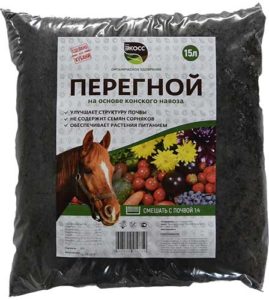
The same can be said about dry bird droppings (the same chicken, in which up to 4% nitrogen).
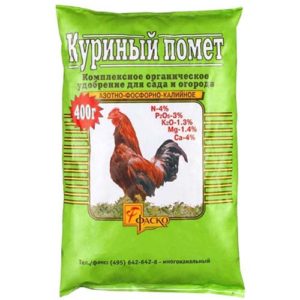
- Compost.
It is no less nutritious (on average it contains 0.8-1.5% nitrogen) than fresh manure or humus.
Compost is obtained as a result decomposition (decomposition) of organic (plant) waste (weeds, tops, cut grass, leaves) under the influence of microorganisms, i.e. as a result composting.
By the way! Compost is also made from animal waste, most often based on horse dung or mullein (there will be more nitrogen - up to 2-3%).
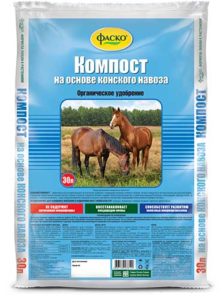
- Horn shavings.
Complex fertilizer (crushed horns and hooves of cattle) containing 18% nitrogen, as well as 17% phosphorus, 16% calcium and other nutrients.
However! This organic fertilizer does not begin to act immediately (after the onset of decay processes), therefore it is usually applied before the beginning of the growing season (in the spring on a garden bed or in a hole when planting).
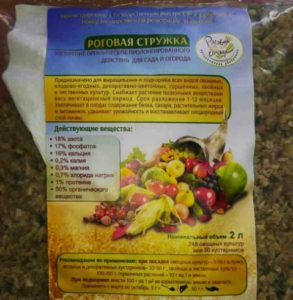
- Siderata.
Advice! The site already has 2 detailed articles about siderates:
- Herbal infusions (for example, nettles).
It is worth understanding! There is very little nitrogen in the herbal infusion, however, it contains a bunch of other useful substances.
How to use organics correctly
Organic nitrogen fertilizers can be added:
- into the soil for seedlings;
- for digging when preparing beds in the open field or in a greenhouse;
Manure and wood ash should not be applied at the same time. It is better to apply manure in autumn, and ash - in spring.
- when landing in a hole or a landing pit;
- for mulching plantings (including fruit trees and berry bushes).
Note! Almost all organic fertilizers have an alkaline reaction, which means that they cannot be used for feeding "acidic" crops (the same heather).
Disadvantages of using organic matter
If everything is clear and understandable with the advantages of organic farming, then the disadvantages of using nitrogen organic fertilizers are still worth mentioning:
- Fresh manure cannot be applied immediately (in spring, summer) - some of the nitrogen and other nutrients will simply evaporate and / or be washed out. Only fill the beds with it in the fall!
The main danger of using fresh manure is the presence in it of many weed seeds, eggs of harmful insects (the same helminth eggs). Therefore, it is much better and more effective to use rotted manure (they also say "dung humus" or simply "humus").
Alternatively, fresh manure can be prepared in the fall: put it in plastic bags or simply cover it with a film and leave it at the summer cottage (for the winter) so that moisture does not get inside and useful macronutrients do not evaporate. Such a six-month exposure (including freezing) will help nullify the presence of various hormones in it, and will also lead to the death of most weed seeds.
- It takes a lot of time to prepare good humus or compost on your own - at least 3-4 years.
- If there is a compost heap in the corner of almost every summer cottage, then you will still have to look for a place for self-preparation and storage of humus.
In any case, organics take up a lot of space.
- In the case of nitrogen starvation, when the plant urgently needs help, organic matter will be powerless, unless you prepare a liquid fertilizing (solution, infusion or extract). However, its effectiveness will be significantly lower than when using mineral fertilizers.
Mineral nitrogen fertilizers
- Carbamide (urea) - contains 46% nitrogen.
Advice! The site already has a detailed article about the features of the use of urea in the garden.
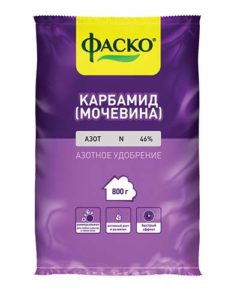
Interesting! Urea often also used as fungicide and insecticide for eradicating early spring (the very first) and autumn spraying (most recent).
- Ammonium nitrate - contains 33-35% nitrogen.
By the way! The site also has a separate article on how what is ammonium nitrate and how to use it correctly in the garden.
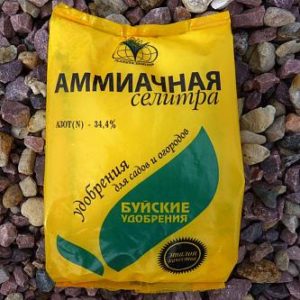
- Calcium ammonium nitrate - 26-28% nitrogen, not less than 10% calcium (up to 20%).
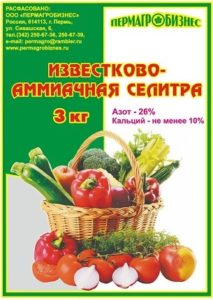
- Ammonium sulfate - 21% nitrogen and 24-26% sulfur.
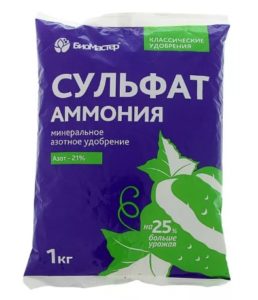
- Calcium nitrate - 14.9% nitrogen and 27% calcium, as well as up to 4% sulfur and 0.3% boron.
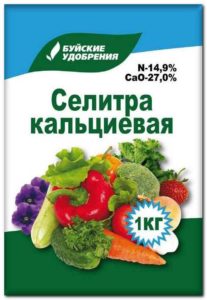
By the way! In addition to pure nitrogen fertilizers, there are also complex mineral fertilizerscontaining nitrogen in a sufficiently high amount (i.e. they need to be applied in spring or early summer):
- Nitroammophoska (all elements 16% each);
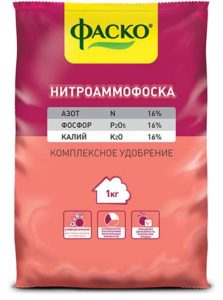
Nitroammofoska can also be called “Azofoska«.
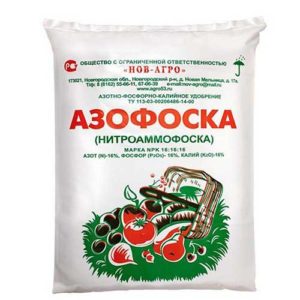
- Nitrophoska (11% nitrogen, 10% phosphorus and 11% potassium).
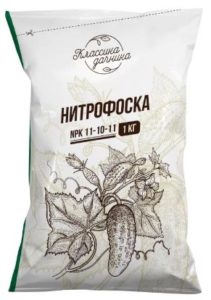
Rules for the use of mineral fertilizers
- All nitrogen fertilizers well soluble in water (it can be in just room or slightly warm, but best of all in hot - 50-60 degrees).
- You can only spill liquid mineral fertilizers on already wet ground (i.e. after watering) so as not to burn the roots of young plants.
- Urea (urea) is most concentrated nitrogen fertilizer, therefore, it is very important not to overdo it with it and apply it at the recommended rate (so that the plant does not fatten).
By the way! Recommended dose for most nitrogen fertilizers - this is 1 tbsp. spoon (10-15 grams) for 10 liters of water (for solution preparation) or for 1 square meter (dry).
However, much more often a matchbox (15-20 gr) is used for dosage.
- Urea (carbamide) does not work at low positive temperatures (optimally above +10 .. + 20 degrees).
Remember! When it's cold and in the snow make ammonium nitrate, after will get warmer — carbamide (urea).
- Urea does not work immediately. In order for nitrogen in the amide form to become available to the plant, time must pass and a whole chain of biological and chemical transformations (reactions) must go through.
Important! In order for urea to be well absorbed, the soil must be rich in organic matter (and bacteria), in other words, it is desirable to apply it along with humus or compost.
- Ammonium nitrate is faster-acting fertilizer, than urea, i.e. contains nitrogen in nitrate (the most easily assimilated form) and ammonium form.
- Urea (carbamide) it is desirable to apply for foliar dressing (spraying on a leaf), but it is also possible for root ones (with a liquid solution, but in a dry form with the obligatory incorporation into the soil).
- Ammonium nitrate can be made both dry (autumn and spring)and feed with liquid solution during the growing season (including making foliar dressing on the leaves, but be careful, as a strong solution can cause burns).
- Top dressing calcium nitrate perform in liquid form, under the root during the growing season, or dry, when preparing the bed before planting (planting) plants in the spring... Also often donefoliar top dressing.
Calcium nitrate is a real salvation from tomato top rot (foliar dressing is done 2-3 weeks before the redness of the fruit).
- Calcium nitrate alkalizes the soil (deoxidizes, i.e. makes it less acidic), a ammonium sulfateon the contrary, makes more acidic... Urea is neutral.
Accordingly, feeding with ammonium sulfate is loved by "acidic cultures" (heathers - heathers, blueberries, rhododendrons, as well as hydrangea, sorrel, conifers).
- Ammonium sulfate and ammonium nitrate (but still better in spring) can be applied in the fall or in the spring (when preparing the garden). All other nitrogen fertilizers - only in spring and during the growing season.
- If you want to completely eliminate the acidifying effect of ammonium sulfatethen you need mix these fertilizers with lime (less effective and even dangerous for plants) or chalk (preferably) in a ratio of 5 to 1.
Alternatively, you can mix 1 to 1 with urea (i.e. 1/2 tablespoon of ammonium sulfate and 1/2 tablespoon of urea).
- The simultaneous use of ammonium fertilizers is not recommended (ammonium sulfate and ammonium nitrate), and amide (urea) together with alkaline fertilizers, for example, with wood ash or again with lime, dolomite flour, in chalk, as it will lead to the loss of ammonia (nitrogen) and highlighting unpleasant odorwhich in turn can provoke ammonia plant poisoning = toxic shock (this is especially true for greenhouses).
By the way! For additional advice and advice on the use of mineral nitrogen fertilizers, see 2 paragraph "Groups of nitrogen fertilizers by forms of nitrogen".
- Accordingly, if you have alkaline soila, then urea is not recommended.
- If you want to add urea directly to the hole when planting seedlings (or in rows when sowing seeds), then together with her it is desirable to add and potassium sulfate (potassium sulfate) and / or superphosphate.
- Ammonium nitrate, like ammonium sulfate, is undesirable to introduce into the wellssince they acidify the soil locally ..
Well, it's time to stock up on nitrogen fertilizers even in winter so that you can start working in early spring. Fertilize wisely!
Advice! When applying any fertilizers, you must comply with the recommended rates and adhere to the rule: “It is better not to feed the plant than to overfeed". This is especially true for nitrogen fertilizers.
Video: nitrogen and nitrogen fertilizers

